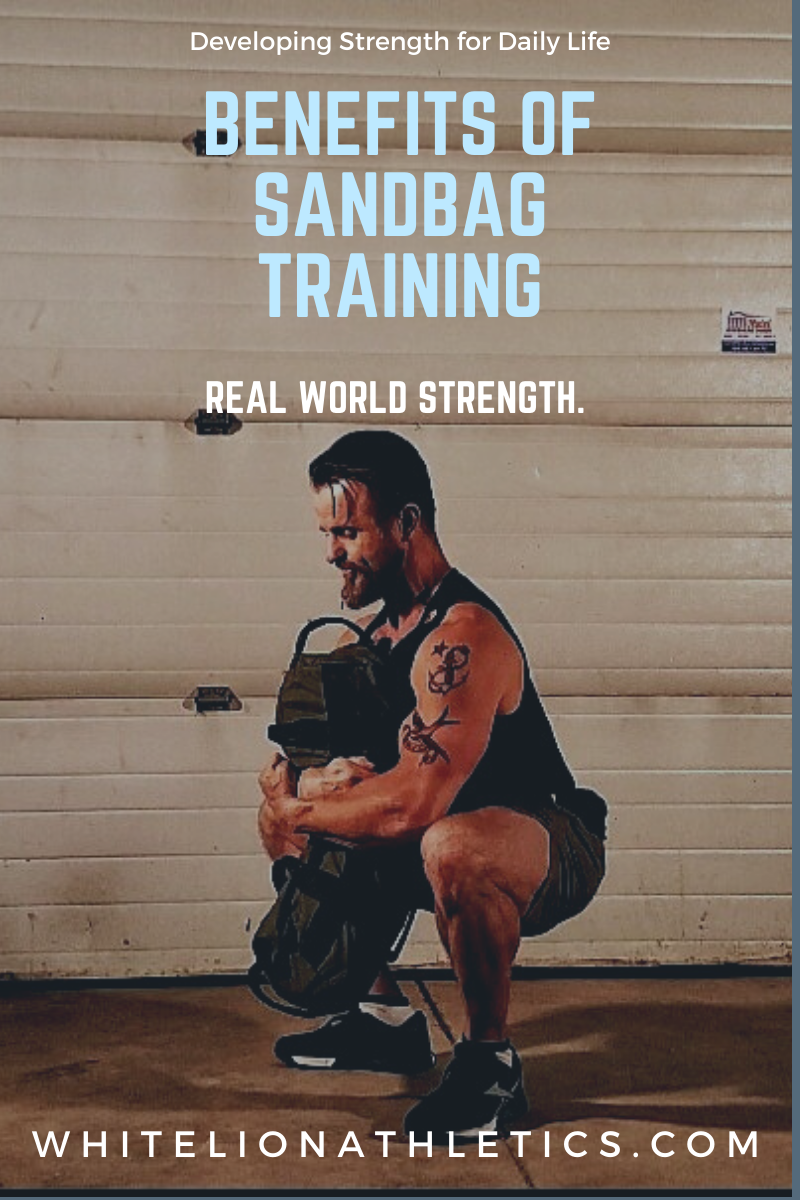The Benefits of Sandbag Training in terms of the squat.
The benefits of sandbag training maybe understood more completely when we consider how the sandbag will be moved (ie in which exercise will the sandbag be the external weight load).
Thinking in these terms may create a deeper understanding of why, how and when sandbags might be introduced and what the desired outcomes of this introduction might be. Specifically: what is the benefit (if any) of adding a sandbag to my squat?
The "benefits" of Sandbag Exercises
What is a benefit? It is an advantage or profit that may be gained from something. We may go even further and say that a benefit is a unique advantage that may be gained when a particular endeavour or action is pursued in a specific way with a specific intention.
A benefit maybe considered context specific or outcome specific. For example, an outcome specific benefit of writing with pencil instead of pen is that pencil can be erased. If you are writing and there will be a need to erase it, using a pencil will be advantageous because a benefit of using pencil is that can be erased. However, in a context where writing is required to be permanent, the “benefit” of the pencil being erasable might become a detriment as it will not achieve the outcome we need.
When asked what are the benefits of sandbag training or what are the benefits introducing a sandbag into this particular exercise we should ask: what outcome(s) are you looking for? Knowing your desired outcomes could be the most important of determining if something is a benefit.
Characteristics vs Benefits
Characteristics are often seen to be synonymous with benefits and this is not always the case. Using the example above: pencil can be erased while pen (generally) cannot be. Being erasable (or not) is a characteristic of each implement; whether or not this is advantageous or beneficial will depend on the outcome you desire.
The characteristics of sandbags are often considered to be benefits of training with sandbags.
Characteristics of Sandbags
- Shifting weight load within the sandbag and resultant instability
- Unfamiliar and awkwardly shaped
- Lower to the ground relative to barbells, dumbbells or kettlebells.
The question might be (and arguably should be): will the characteristics of a sandbag benefit my training? More specifically, will the characteristics of a sandbag be beneficial if it is introduced into a specific exercise to achieve a certain set of outcomes?
Posing the question in this way may shift your focus to your fitness goals and your starting point instead of choosing a sandbag because it worked when someone else introduced it into their training.
Characteristics of a Sandbag: How you decide to move it will determine what you need to move it.
Sandbags are designed in a variety of ways so shapes and dimensions vary, and each comes with their own characteristics and potential benefits. When we discuss sandbags here, we are referring to the White Lion Athletics 8-Handle, adjustable Sandbags.
“How you move it”
How can you move a sandbag? Sandbags can be introduced into any exercise you already do (squatting, deadlifting, etc). However, what will be required to move the sandbag during that exercise may be dramatically different from any other weight load that might be lifted.
100 pounds will always be 100 pounds; however, how you move it and what is required to move it will depend on characteristics of that particular weight load such as:
- Its shape
- How close it is to the ground
- Presence of handles
- Weight distribution: even or offset
- Continuity: is the weight fixed in position or can it shift ?
“what is required to move it”
What, exactly, are we referring to? Range of motion, flexibility, mobility, and stability. We will revisit the terms above and explain them after we use the barbell back squat as an example below.
First of all – and just quickly to provide context – what is a joint’s range of motion? Range of motion (ROM) is the amount of movement of a joint.
It is the distance a joint can move and the direction in which it can move. There are established ranges that are considered normal (or ideal) for various joints in the body that are measured in degrees of a circle. ROM can be active, passive or a combination of both.
Active Range of Motion is the distance and direction a joint moves in due to muscular contractions alone – there is no external assistance
Passive Range of Motion is the distance and direction in which a joint moves when someone (or something) is creating the movement, such as a physical therapist.
Flexibility is defined as “the ability of a muscle or muscle groups to lengthen passively through a range of motion”. Mobility is the “ability of a joint to move actively through a range of motion”.
Stability can be defined as "the ability to maintain and/or control joint movement and position. Stability is achieved by the coordinated actions of the surrounding tissues and neuromuscular system." (1)
Comparing Available Loading Options: Sandbag Squat vs Barbell Squat
Squatting with a sandbag presents at least thirteen different loading options and some options are unique because of the 8 handles (4 sets) that are available. All thirteen of these loading options are explored in our Sandbag Training Manual PDF and we will review two of them here.
The most compelling point to bring attention to is that moving the sandbag onto your body to perform the squat with any of these loading options will be done by moving the sandbag from the ground onto your body and securing it.
Loading from the ground requires more mobility, flexibility and stability than loading the barbell on to your body from a squat rack to perform a barbell squat. The loading method that is available to you for the barbell squat is not a negative aspect – it’s simply a feature or necessity of this exercise.
Example #1: The Front Rack Squat
Using with the Front Rack Squat as an example, a benefit using a sandbag is that you will need to Clean the sandbag into the front rack position in order to perform the Front Rack Squat. The Clean will require the execution of the hip hinge to move the sandbag into the rack position. For a complete discussion of the Hinge and the Squat, please refer to our Sandbag training manual and our video training library.

Generally, the barbell front rack squat is performed by taking the barbell out of the squat rack. The introduction of the clean to the sandbag front rack squat incorporates the hip hinge which increases the overall requirements for mobility flexibility and stability. There is an increase in overall muscle recruitment in the sandbag front due to the incorporation of the clean for the glutes, hamstrings and core.
The front rack squat aside, each of the loading patterns available for the squat will require different amounts of mobility, flexibility and stability due to the sandbag’s location on your body. The availability of these options will highlight a number of other benefits on an a position-by-position basis.
Example #2: The Bear Hug Squat
Let’s take the example of the Bear Hug Squat with a special note that this loading position is not available for the barbell squat.

Similarly, moving safely from the bottom of this squat to standing will increase the demands for mobility and stability as your hip and knees joints might not normally move through those ranges of motion with an external load.
The Bear Hug Squat can also increase the overall demand of your squat because the sandbag needs to have its position secured against your torso while maintaining a neutral spine. Constant tension needs to be applied to prevent the sandbag from slipping during the exercise. Your chest, arms and shoulders are working to secure the sandbag while your spinal erectors are working to keep your torso upright.
Example #3: Single Arm Front Rack Squat
Another benefit of introducing the sandbag into the squat is that you have the opportunity to asymmetrically load your squat by having the weight secured on one side of your body only. In addition to this, you also have the option to choose from multiple handles to secure the sandbag in that loading position and each has its own benefit.
Similar to the Bear Hug Squat, the starting position for this exercise (regardless of handle choice) will be at the bottom of low and stable squat position.
Each handle will allow the sandbag’s weight to be distributed differently and each variation will require different amounts shoulder, core, and wrist stability and in addition to upper body strength.
Using a handle in Set #1 will position the sandbag in a vertical orientation. The sandbag will be in line with your forearm (and against it) as well as in line with your torso.

This positioning provides support for the sandbag and makes it comfortable to hold; it also creates relatively low demands for shoulder, wrist and core stability relative to other handle options.
Using a handle in Set #2 will position the sandbag perpendicular to your forearm. This will result in some weight being in front of your forearm and away from your shoulder and torso. This distribution of weight may create an effect of: bending and twisting at the torso; extending the elbow joint; and moving the upper arm away from the torso.

The mentioned effects will increase the demands for anti-rotation from the core and hips and increase demands for stabilizing your shoulde
Using a handle in Set #3 will be an awkward handle to use if your arm is not aggressively being squeezed in your torso with coordinated effort from your chest, shoulder and bicep.

The design of the handle is complemented by the action of “hugging the handle” into your chest – this will secure the sandbag against your torso by stabilizing the elbow, shoulder and wrist joint. If this does not happen, your wrist will get moved into an extended position and the sandbag will likely twist away from your torso. Although shoulder stabilization is a major component of using this handle successfully, there is a large demand for anti-flexion at the torso as well as anti-rotation because of the load position of the sandbag being at an angle to your forearm.
Conclusion:
When considering the benefits of sandbag training it maybe help to consider the how the characteristics of the sandbag will safely and reasonable add to the demands for mobility, flexibility and stability of the exercise in mind.
We discussed the squat alone so that we might think of the sandbag's potential benefits in terms of this movement only. We did this so we could propose a method of evaluating benefits on an exercise-by-exercise basis. We believe that this method will allow for sandbags to be introduced into someone's training in a purposeful way with specific intention.
It is important to understand the characteristics and benefits associated with sandbag training to fully gain an appreciation (or better understanding) for what it takes to move a sandbag during a squat and how sandbag specific exercises might be applied to your own training to reach a certain goal. Stay tuned for an overview of more Sandbag related topics. (Link to product page).
References
- Thompson, Nicole. “Joint Mobility and Stability”. March 7, 2019. https://www.acefitness.org/fitness-certifications/ace-answers/exam-preparation-blog/1189/joint-mobility-and-stability/
About the Authors
Ryan Bobychuk B.Kin CSEP-CPT: Performance coach, with an interest in sports specific training, especially hockey.
DJ Guzda, MA : Director of White Lion Athletics and owner of White Lion Strong- Gym in Winnipeg. Kettlebell coach; Steel Mace Flow L1 (Hons); Steel Mace Specialist (Rik Brown).

